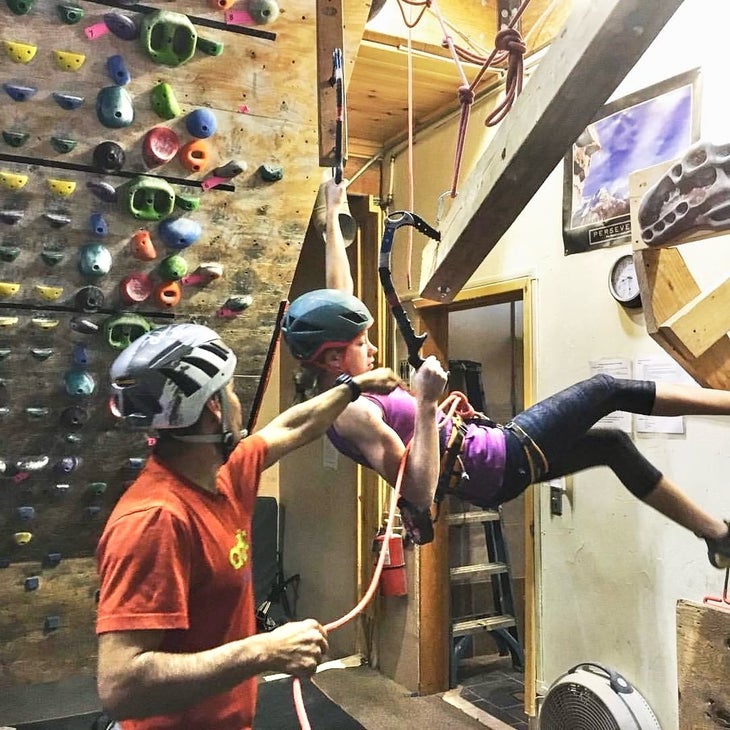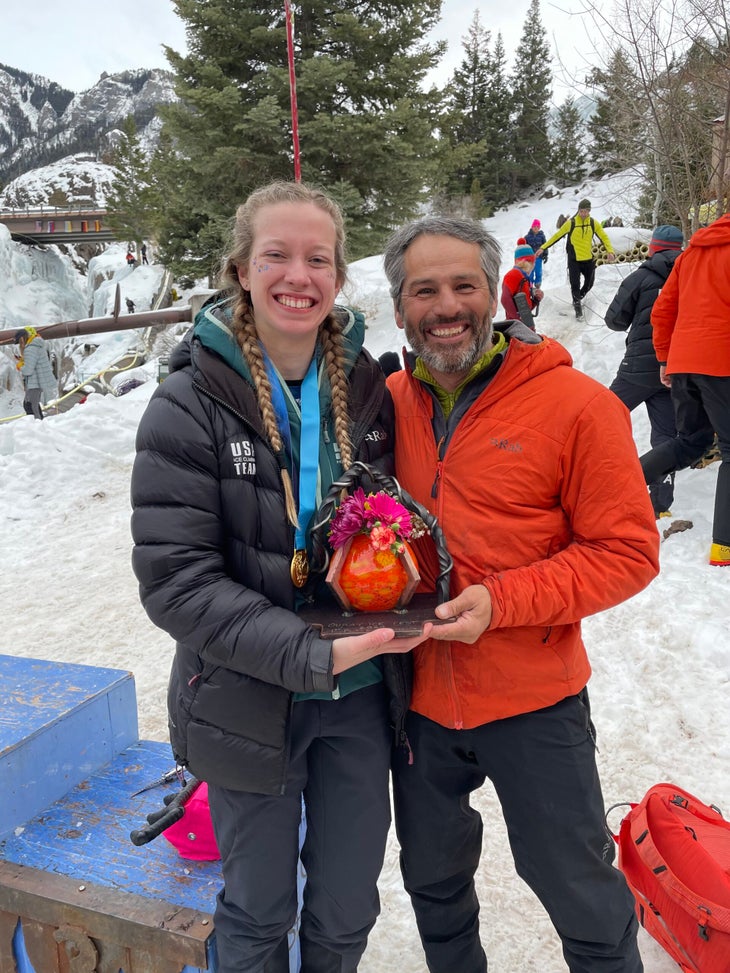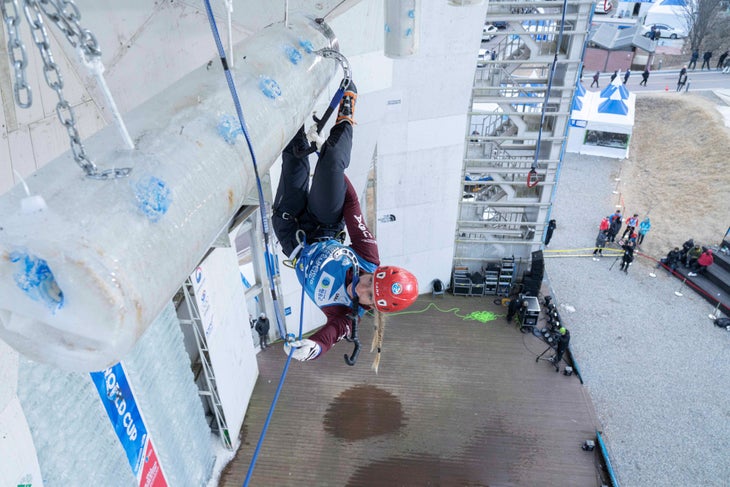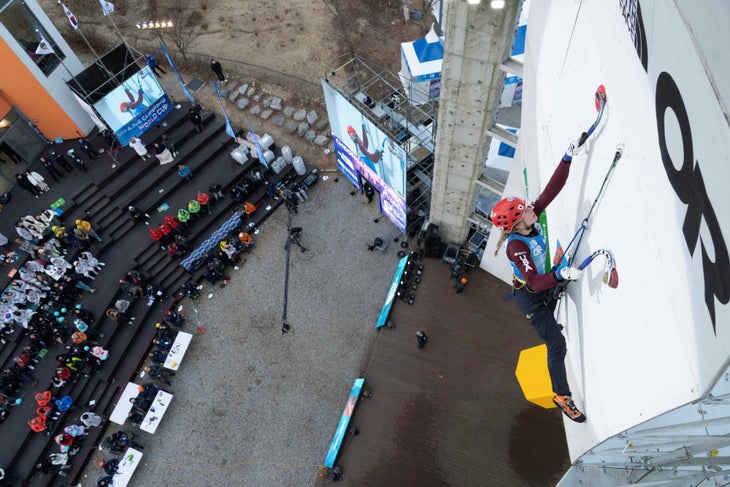Meet the Young Ice Climber Putting The US Team on the Map
In 2023, Catalina Shirley took a life-threatening fall and questioned whether she’d ever lead again. This year, she returned to the site—and became the first American to podium in an Ice Climbing Lead World Cup.
Heading out the door? Read this article on the new Outside+ app available now on iOS devices for members! Download the app.
Slats of sun fall through the coffee shop’s high windows, casting shards of light and shadow over the patrons within. I’m one of them, sitting on a bench with my back to the glass, staring across the table at the woman who was once my greatest rival.
Catalina Shirley blinks in the light. She’s 21, tall, and lanky, with a mane of curly blonde hair she usually keeps in a pair of tidy braided pigtails. She’s got a gentle voice, pale blue eyes, and a wide smile. It’s a face you’d expect to find on a Disney princess, not on a hard-charging, internationally ranked, three-time U.S. National ice climbing champion.
I watch her cup her latte with her hands, smiling at me. And I think about how strange it is to be a journalist sometimes. A few days ago, Cat and I were battling it out on an ice-encrusted climbing structure in southwest Colorado, going head-to-head in a high-caliber international competition just as we have for years. Today, we are wearing jeans and drinking lattes, and I will ask her, on journalistic record, how exactly she got so much better than me. Then, I will call her mother and ask the same question.
The stranger thing is that her answer actually matters—and not just to me on a petty, personal level. Catalina is a case study of climbing for all the right reasons and using that pure, joy-fueled motivation to achieve enormous success. She’s a full-time student, works part-time, and grew up in an average household. Her parents weren’t climbers. She wasn’t born with abnormal opportunities or mutant-level DNA. She just found a way to work with what she had. And in doing so, became proof of what’s possible—for me. For women. For everyone.
***
I first met Cat in December of 2016. I was 23, and she was 14. I was a reporter, and she was a youth competitor at the UIAA Ice Climbing World Cup in Durango, Colorado. At the time, I had no idea what competition ice climbing really was; I was just there on assignment.
The competition structure stood in a brewery parking lot. It was a hulking, ramshackle tsunami wall cobbled together from plywood sheets and two-by-fours. I shuffled around it, weaving around knots of climbers from Korea, Russia, Ukraine, Italy, and Japan, looking for people to interview. I spotted Cat and assumed she was a local child searching for entertainment. I introduced myself. She told me she’d participated in the youth competition that morning. Then, shyly, she revealed she’d placed second.
“How long have you been ice climbing?” I asked.
“I just started a couple of months ago.”
She was small and soft-spoken. I had to stoop to hear.

“That’s just how she was as a kid,” Katy Shirley, Cat’s mother, told me over the phone last month. “Catalina was always kind of quiet and shy. She was so unassuming.”
But she was also very high-energy. Cat’s parents tried enrolling her in soccer, gymnastics, and other sports, but none really clicked. Then, after watching their 7-year-old daughter stem up the narrow hallways in their home, they decided to enroll her in a local YMCA climbing camp. There, she met a 12-year-old girl named Bridget, who took young Cat under her wing.
“I wanted to be on a climbing team like Bridget,” Cat recalls. “She was my first mentor.”
When Cat was nine, the family moved from San Diego, California, to Durango, Colorado. There, they enrolled her in the tiny climbing program at The Rock Lounge, Durango’s now-closed climbing gym.
The Rock Lounge’s head climbing coach, Marcus Garcia, eventually convinced Cat to join his side project: a fledgling youth ice climbing team. It was the first of its kind in the country.
While Cat seemed to enjoy the ice climbing, Garcia said she wasn’t exactly a natural.
“She was shy and timid and afraid to fall with the ice tools,” he says. “And she was lanky, wiry, tiny. She probably weighed 80 pounds when I first met her. ”
The first time I competed against Cat—at a small local event in the spring of 2017—I remember being astonished at how slowly she moved. At age 14, she was as shy on the wall as she was on the ground. Most competitors can flip the switch into go-mode when they need to. Cat didn’t seem to have a switch at all.
“But then something started to click,” Garcia says. After a few seasons of experience, Cat became more comfortable with the tools. She found a certain fluency with them. She’d always been hard-working, but now she had just enough confidence to put her other superpower to use: her tenacity.
“Looking at her you wouldn’t know it, but inside she’s very determined and tenacious,” Katy Shirley says. “She wouldn’t give up on things.”
Within a few years of knowing Cat, I realized that myself. If she got to a crux during a competition and couldn’t reach a hold, she would sit back and consider it. Then she would throw for it again—and again and again. Sometimes, she would be in the same spot for minutes, trying repeatedly.
It wasn’t a frustrated, self-flagellating sort of repetition, the way you see some climbers do. Instead, Cat’s efforts seemed to come from a simple sense of curiosity. She wanted to know how it could be done. And she was certain that if she kept throwing, it would have to happen sooner or later. So, she’d sit there, calmly working out the problem as the audience held its breath. It was like she’d just sort of forget that she was supposed to be tired.
The year after that first competition in 2017, Cat and I made the U.S. Ice Climbing Team. Back then, I outperformed her a lot of the time. To me, she was still just a kid. Then, around 2021, something changed. Cat found her switch.
***
To understand Catalina Shirley, you have to understand her coach. Catalina’s determination, strength, and cunning are all her own, but her climbing philosophy largely comes from him.
Marcus Garcia is a Durango-based professional climber and guide. In his nearly 30 years of climbing, he’s notched hundreds of first ascents, including desert towers and scarcely repeated big-wall routes on El Cap.

In 2016, he embarked on a dubious new experiment: he gathered together a small band of Durango children, strapped tiny knives to their feet, put axes in their hands, and decided to turn them into America’s first youth USA Ice Climbing team.
Over the years, all those kids have gone on to become incredible prodigies. One, Keenan Griscom, became the youngest American ever to win the Ouray Elite Mixed Climbing Competition at age 16. Another, Kevin Lindlau, sent the world’s hardest known drytooling route (Aleitheia, D16) just last month. Young phenom Liam Foster became the youngest American to climb the famous Line Above the Sky (D15) at age 19. Last year, he sent his first 5.14c. And just a few weeks ago, Catalina Shirley became the first American to podium in lead at an Ice Climbing World Cup. Not the first woman, but the first American. Ever.
Even more impressive, Garcia still acts as a mentor to most of them.
“He’s not their coach for just a few years or a season,” says Katy Shirley, Catalina’s mother. “He’s really in it for life.”
When Cat was in middle and high school, the local parents would drop their kids off with Garcia for weeklong trips. Sometimes, those trips were to competitions in Denver or Colorado Springs. Sometimes, they were abroad.
“A bunch of us went to France with Marcus when I was 14. It was my first time traveling abroad without my parents,” Cat recalls. “We were there for a week, and he figured out how to house all of us and feed all of us and drive the stick-shift van with all of us.”
Cat says Garcia always seemed to put them first, even though he was running a gym and a construction business back home.
“A lot of his own life had to go on the backburner—including his own competition climbing—so that he could focus on us,” Cat says. “He’s very much a giver, and he gave a lot to us kids.”
Even today, despite their busy schedules, Garcia finds time to send Cat training plans and talk through her performance at every competition. When Cat has good or bad news to share—in climbing or life—she calls Marcus.
“Anytime she calls, he’ll respond,” Katy Shirley says. “For him, it’s like she’s his kid, as well.”
Garcia was also adamant about treating all kids equally—regardless of age or gender. In his gym, there was no beginner or advanced category. Everyone did the same workouts. Katy Shirley recalls a competition in Colorado Springs where he had all the kids compete against each other on the same route for the same podium.

“So, of course the girls came in fourth and fifth and didn’t make it on the podium,” says Katy. “And that was kind of a bummer for them, but you know what? It made them stronger.”
It showed Cat that in his heart of hearts, Garcia truly believed that the girls could climb as well as the boys.
“I think that was more valuable than standing on the podium that day,” Katy says. “And I think she carries that belief with her.”
***
Like most of us, Cat spent her first few years climbing just trying to figure out what the hell was going on. She was often scared. Her equipment was old and outdated. She frequently misread routes in competition. But she loved the movement.
“Because the handles of the tools are basically jugs, you can pull really, really hard,” she says. “And each of the holds demand a very specific movement. Maybe you have to cross or match your hands on the tool to lock it off in a certain way. And the holds are a puzzle, too—often there’s just one tiny divot that you need to find with the tip of your pick before you can move onto that hold. People say they like rock climbing because it’s a puzzle, but drytooling is that to a much greater extent.”
So she kept going. Around 2021, she started to get better. But she wasn’t acting like it.
Cat recalls sitting in the isolation zone at a World Cup in Korea last year, having just made her first World Cup finals. Women from a half-dozen different countries surrounded her. As always, they huddled around their drawings of the finals route, chatting and sharing beta.
Then, a Dutch competitor, Marianne Van Der Steen, looked over Cat’s shoulder and saw that she had only drawn the first half of the route.
“That’s not the whole route,” Van Der Steen told Cat. “Why are you looking down there? You should be looking at the top. You’re not going to win by only getting halfway.”
Cat realized she’d been so consumed with worry that she’d never given herself permission to really try.
“I thought the most important thing was to move really carefully and stay on the wall and do the moves one by one,” Cat says. “I never thought about the bigger picture, which is ‘Maybe I could do really well,’ or ‘Maybe I could even top this route.’”
These are things that many climbers rarely let themselves think about. Success can be as terrifying as failure.
I’ve always tried to go into competitions with low expectations, so I’d be happy no matter the outcome. This is when Cat began to surpass me; she realized that that kind of thinking was holding her back before I did.
***
By the end of that season, Cat had decided that she wouldn’t play it safe anymore. She was going to really open up the throttle. If she fell early because she was trying hard and moving fast, so be it; she knew that she’d never get to the top if she didn’t take some risks.
“She realized then that she could push out of her shell, not just as a climber but as a human,” Garcia says.
For a while, this worked. Cat left me in her dust during the 2022 Ouray Elite Mixed Climbing Competition (and has come in first place every year since—taking gold three seasons in a row). She started climbing faster and getting further on every competition structure she touched.
Then, Korea happened.

In 2023, Cat competed at the UIAA Ice Climbing World Cup in Cheongsong, South Korea. Climbing here is a big deal. The facility was designed specifically for ice climbing World Cups. The wall accommodates eight climbers at a time. It has two refrigerated ice panels designed for speed climbing. There’s stadium seating. The whole community comes out to watch.
On this particular weekend, Cat did well in semi-finals and moved on to finals. She clipped the first few bolts in good time and moved into the overhang. After a few more clips, she entered the first of several moves traversing a massive roof. There, she got stuck.
She had one tool hooked into an ice barrel—a frozen cylinder suspended from the roof by a chain. She was hanging onto it with one hand, her leg crossed over that wrist in the customary figure-four position. But she couldn’t make the next clip. She hung there for nearly two minutes, trying over and over again. But then, somehow, the rope got tangled. The ice barrel spun, and the rope looped around Catalina’s neck. She couldn’t go backward, and she still didn’t have the reach to make the next clip. She spent about 20 seconds desperately trying to untangle herself, but nothing worked. She felt the rope tighten across her throat. She felt panicked.
“Right before I fell, I thought, ‘If I let go, I’m going to die,” she says. Then, completely out of gas, her hands peeled off the tools, sending her body cartwheeling through the air as the rope untwisted around her. She got lucky—she walked away uninjured, aside from a massive rope burn across her neck.
Still, the fall terrified her. She called Marcus, crying. She told him she didn’t know if she’d ever be able to lead again.
“We talked about it, and we realized that all this was stemming from a lack of trust,” Garcia says. “She needed to learn to trust herself and to trust others.”
“I’d been competing like comps were the most important thing in my life,” she says. “And yes, I want to be able to give 100% in a comp, but the most important thing in my life is being able to climb again and be with my friends and family. Comps can come second to that. The priority is being safe. I used to figure-four over the rope or flag behind the rope all the time, which is risky but felt worth it if it would save me a few seconds on the competition route. I don’t do that anymore. Even if it costs me extra energy, I’ll move the rope out of the way and do the move again.”
***
Cat worked with Marcus on her mindset for much of the next year. Still, when she returned to Korea in January 2024, she was scared.
“I was afraid climbing on that structure again would be really hard for me, but it wasn’t,” she says. The work had paid off. She felt relaxed. She was confident in her ability to do well—and in her ability to keep herself safe.
Qualifiers went well. And when the dust cleared after semifinals, Cat was in first place.
After finals route preview, Cat remembers sitting in isolation with all the other women, sharing beta and joking together like they always do. She remembers looking down at her drawing of the finals route and remembering Van Der Steen’s advice. She smiled. This time, she’d drawn the whole route.
When her name was called, she walked out to the competition structure, feeling nervous but in a good way. In her head, she wasn’t thinking, I could fall. She was thinking I could win.
The route was powerful but flowy—standard Korean style. Cat sprinted through the first section, swiftly gaining the roof. There, she reached the first ice barrel. For a moment, fear flashed through her mind. This time, she fought it down.
“I knew I wasn’t going to fall—I wasn’t going to let it happen again,” she says. She flipped the rope over her tool, clipped the draw, and then swam up the rest of the 60-degree roof and onto the headwall above. There, the climbing was techy and powerful, but Cat kept going. By the time she fell—on a massive dyno near the top of the wall—she’d shot to the top of the women’s rankings. In placing second, Cat became the first American to podium in Lead in an Ice Climbing World Cup.
***
Garcia wasn’t there, but he was watching.
“I woke up at 1:00 AM, and I was sitting in bed watching on my little phone screen. And when I saw what she did—she didn’t make the dyno but she made history for the women of the U.S. and for this sport. I just broke down and cried.”
Cat competed in Speed the same weekend and notched a second silver medal in that discipline.

“It’s absolutely noteworthy and a huge success for the U.S. Team,” says Kendra Stritch. Stritch is one of Cat’s teammates and the first American to win a gold medal in Speed in an Ice Climbing World Cup in 2015. “Cat has obviously put in a lot of time, but it seems like things are really coming together for her this past year.”
More generally, it’s been a big season for women in ice climbing. Not only did Cat take home two silver medals, but in November 2023, Katie Stylos became the first American woman to send D15 with a historic ascent of Line Across the Sky in the Italian Dolomites.
In the past, competition ice climbing has been small in the U.S. But with big-profile achievements like these making the news, that could soon change.
“The overall popularity and awareness of drytooling in the U.S. is absolutely up,” Stritch says. With Stylos’s and Shirley’s leadership, she expects that trend to continue.
Shirley certainly hopes so.
“People sometimes ask me if I was the first American woman to podium, and I’ve corrected them—‘No, I’m the first American, period.’ I don’t have any shame about that,” Shirley says. “For me, that feels huge. When I was young, Marcus always stressed that there was really no difference between male and female drytoolers. It’s not just having big muscles, it’s about strategy and experience. This feels like proof of that.”
So do some of Cat’s other performances. During U.S. Team Tryouts last fall, she topped all four of the dual-gender qualifier routes—something none of the men were able to do. And in the 2024 Ouray Elite Mixed Climbing Competition, where both genders also climbed the same routes—albeit with slightly different starts—Catalina made it further than all but two of the men. That included landing a massive dyno that spit off most of her male counterparts.
“It was amazing,” says Garcia, who set the route in Ouray. “I saw her fly.”
***
Back in the coffee shop, I closed my laptop and asked Cat my last question.
“Do you ever feel burned out?” I asked. Maybe I was projecting; I’d quit the competition scene more than a year ago. It’s a hard sport to be a woman in. The community is tight-knit and supportive, but I often felt like an outsider. Like I’d never be good enough.
I’d always wondered how Cat had found the strength to carry on—through the failures, the injuries, the rejection, the lack of funding—when I had been unable to.
“Do you ever think about quitting?” I pressed. She smiled.
“Every competition.”
“Then why keep going?”
“Drytooling challenges me in every possible way. It’s not something I can get in my everyday life. Maybe I’m tested mentally one day in school, or physically in the gym. Maybe I’m solving a problem one day, or getting scared on a rock climb another day. But I’m never doing it all at once like I am while competing.”
Sometimes, those stars can align in the backcountry, she says. Maybe you analyze the snowpack correctly, climb a route that challenges you, and overcome fear all in the same day—but in competition, you have all that plus a massive community. It really takes a village to put on a World Cup or even a small local comp. It takes volunteers, routesetters, athletes, and judges. People have to travel from all over the world to make a competition happen, and all anyone wants is for everyone else to do well. Because in a sport as small as drytooling, that’s the only reward available.
“Sure I won some money in Korea, but it was just enough to cover the trip,” Cat laughs. “It’s cool for a sport to be recognized, but it’s also cool when it’s not—because it means I’m not climbing for the recognition, I’m climbing because I love the movement and love everything about it. The gold medal isn’t even real gold.”
That was my answer. That’s what Cat had that I didn’t: joy. I was always climbing for rank and recognition. Cat never was.
We stand up and hug goodbye. We promise to meet up at the gym soon. As the door closes behind me, I realize how glad I am that things have changed. Because now I have this woman in my life not as my rival, but as my friend.
The medal may not be real gold. But some things are.
